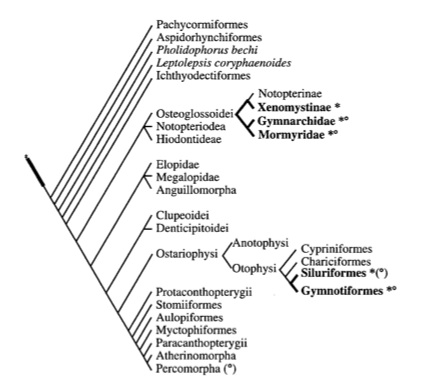South American Gynotiforms: Conductance as Communication
Biology 342 Fall 2011
Moriah Gottman and Misha Naiman
Phylogeny
There are two different species of electric fish, the Central American gymnotiform and the African mormyrids, which are thought to have evolved electric organscompletely separately. We will be focusing on the phylogeny of the gymnotiforms:
Research being done on comparing electric organ evolution between two different gymnotiforms show that both species originally had two copies of the gene which code for the electric conductance in fish, Nav 1.4a and Nav 1.4b. Nav1.4a is only found in the electric organ, while the Nav1.4b is found in the muscles and scales of the fish.
As the fish in the species evolved Zakon et al found that they were less likely to express the gene in muscles and scales, showing a specialization in electric conductance in its' electric organ. This specialization is costly to the fish, in that it can no longer express the gene in its' muscles and scales, but the extra copy of the gene allows phosphorylation and methylation to control gene expression in the moment without damaging the muscular viability of other areas of the fish if one gene is turned off. Nav 1.4a might allow for the evolution of species-specific communication currents that cannot be intercepted as easily by predators because it fine-tunes the EOD. After forming a phylogenetic tree based on experimental observations and fossil records, Zakon et. al (2006) came to the conclusion that the Nav 1.4a gene is being selected for positively in an accelerating manner and that the product of this evolution can be tracked in the widely diverse average frequencies of EOD for each species of electric fish.

Figure 3. A phylogenic tree of bony fish, with * signifiying electroreception and (*) signifiying fish with electrogenesis.
The presence of both genes was observed in basal teleosts (other gymnotiforms, or South American knifefishes, Apteronotus leptorhynchus and Brachyhypopomus pinnicaudatus and non-electric species Osteoglossum bicirrhosum, Notopterus chitala, Ictalurus punctatus and Danio rerio as well as in the mormyriform, or elephant fish, Gnathonemus petersii). The neurogenesis of pacemaker neurons, visualized VIA staining, tends to increase by three to seven times from pre-mating to mating season and in a more social and enriched environment. "Changes in expression and evolution of the same gene are associated with the independent evolution of signal complexity" (Zakon, Lu, Zwickl, and Hills, 2006). "The widespread occurrence of both genes and their presence in basal teleosts indicates that they duplicated earliy in teleost evolution, likely the result of genomewide duplication."